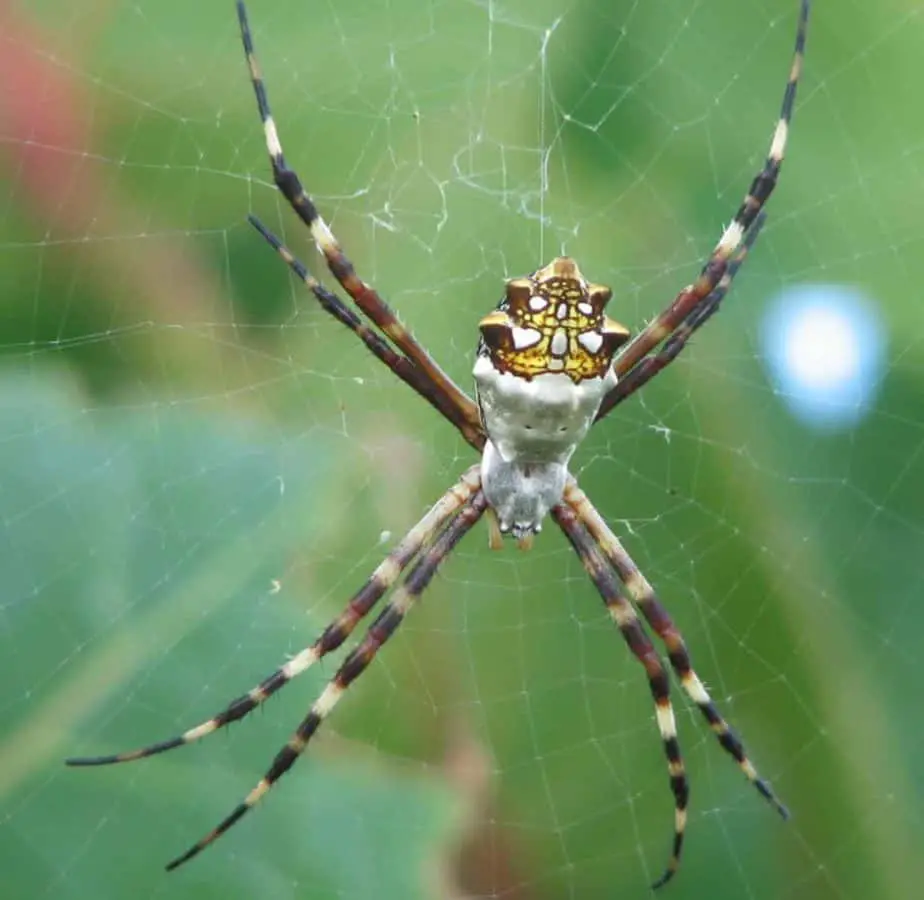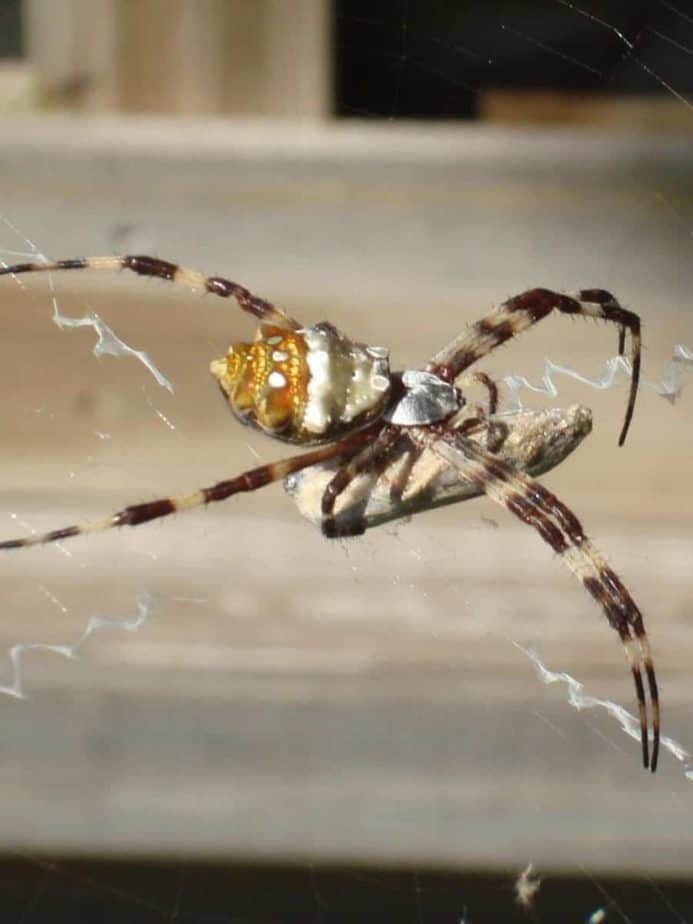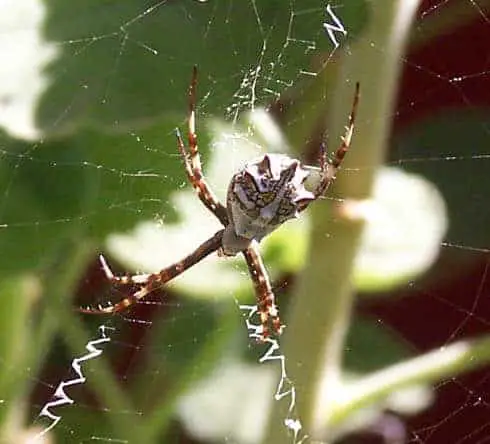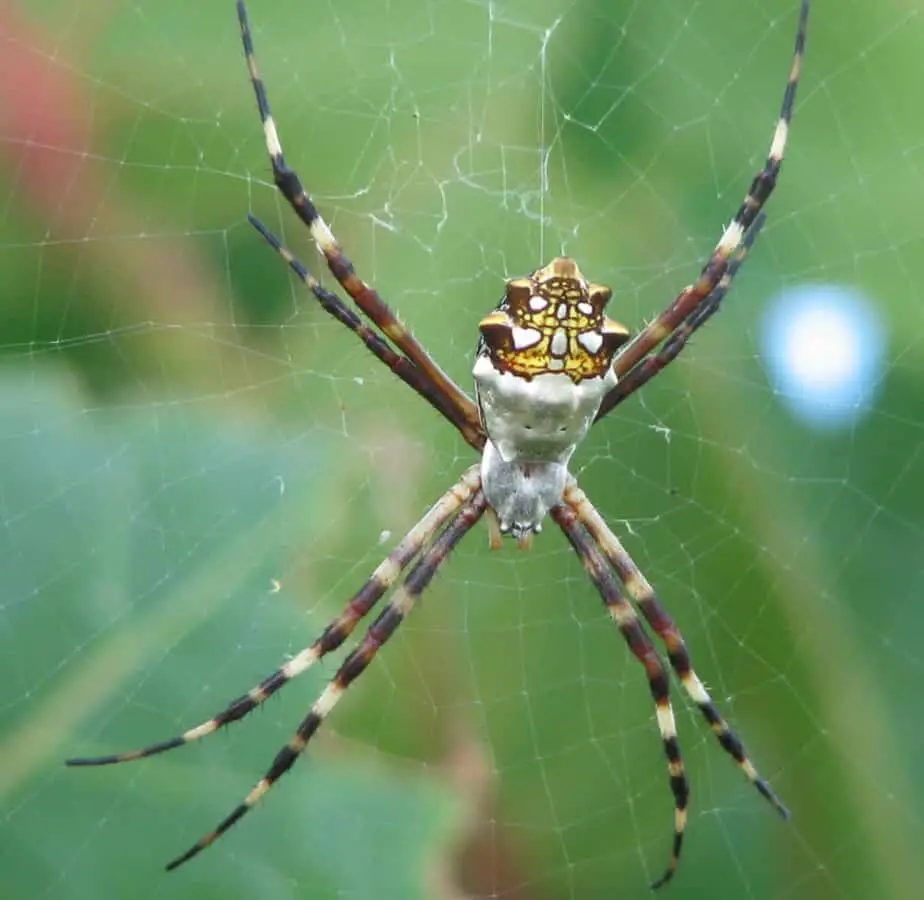The silver garden spider, Argiope argentata, is a common orb weaver in the warm and humid regions in the Southern United States, Central America, the Caribbean and South America. It spins large, orb shaped webs to catch flying insects. As other Argiope spiders, the silver garden spider is often seen in the center of the web with its eight legs spread out in pairs, forming an x-shape. The abdomen of the silver garden spider is white or silver with five spines with orange, yellow and black markings on them.
Argiope Argentata Spider Description
The silver Argiope has a silver or white cephalothorax (head) and abdomen. The back of the abdomen is adorned with several spines with orange, yellow and black coloration. The legs are orange with several black or dark brown bands towards the end.

The light-colored body parts are reflecting UV-light similar to flowers. This feature and the peculiar shape of the spider confuses butterflies, moths and other prey animals into thinking that the spider is a flower that can be pollinated. As soon as the touch the web, they’ll get stuck and the spider will deal a paralyzing bite before wrapping them up in silk.
The spider is most commonly seen in the center of its web with its legs spread out in pairs, forming an x-shape. The underside of the spider has a yellow or white horizontal stripe on a dark background.
Size
As other argiope spiders, the silver argiope is a relatively large spider with long legs. An average female specimen reaches a body size of 0.5 inches (12 mm) with the possibility of growing up to 1 inch (24 mm). With its legs spread out, the spider can reach a size of up to 3 inches (7 cm).
The male spider is much smaller than the female, reaching only about 30% of the female’s body size. Argiope aurantia is also one of the spider species where the male is killed and often consumed after mating.

Web
As part of the orb weaver family of spiders, Argiope argentata spins a large orb-shaped web to catch flying insects. The web can be several feet in diameter and is often spun between trees or large flowers, trees, prickly-pear plants or on front porches.
As the body of the spider, the silk used to spin the web also reflects UV-light to attract pollinating prey animals.
Argiope aurantia often builds stabilimenta into its web to add additional stability. These elements often look like white zig-zag shapes in the web. This behavior is similar to that of other Argiope spiders in the United States such as the black and yellow garden spider (Argiope aurantia) or the banded garden spider (Argiope trifasciata).

Argiope Spider Bite
Argiope spiders are non-aggressive spiders and rarely bite humans or pets. In the rare cases where a bite happens, it generally does not have any effects other than some localized pain and swelling, similar to a bee sting. It is still advisable to treat and bite with disinfectants to prevent secondary infections.
Garden spiders are great to have around the house for insect control as the catch annoying mosquitoes and other flying insects.
Geographic Range of the silver garden spider in the United States
Due to its preference for warm and humid weather, the silver argiope only occurs in the Southern United States in Southern California, Florida, Arizona and Texas. Outside the United States, the spider is found in Central America, South America and the Caribbean.
Argiope Argentata Scientific Classification
- Kingdom: Animalia
- Phylum: Arthropoda
- Subphylum: Chelicerata
- Class: Arachnida
- Order: Araneae
- Infraorder: Araneomorphae
- Family: Aranidae
- Genus: Argiope
- Species: Argiope argentata


I didn’t see this one myself, but this image was sent to me by a friend from the Dallas, Texas area for identifying. I’m usually pretty good at figuring out what species she sends me (although my own expertise is tarantulas rather than true spiders), but this guy stumped me. At first I considered some type of weaver by its stance, and currently I’m leaning towards some type of crab spider, but I can’t seem to find anything matching that yellow and red abdomen pattern anywhere! At this point, I’m just curious. Sorry I don’t have a better picture!
Hello Zeke, thanks for getting in touch! This is a garden orb weaver of the genus Argiope. They are not medically signficant spiders. I can’t make a definitive ID off the picture itself, given the colors and quality but my best guess is that this is a silver garden spider (Argiope argentata): https://usaspiders.com/argiope-argentata-silver-garden-spider/
Hello-
We have four black and yellow garden spiders and three of them have a smaller spider that’s camped out not to far on their own smaller web. Is this some type of symbiotic relationship or maybe the male?
This spider is in my flower bed. Can anyone help ID it please? Frisco, TX.
Hello Margaret, this is a black and yellow garden spider (Argiope argentata): https://usaspiders.com/argiope-aurantia-yellow-garden-spider/
They are great to have around as pest control and are not medically significant.
Spider I found in my backyard, only a bit bigger than a dollar coin. Primarily yellow with long legs that have black and white stripes. I tried using the identification but my location isn’t an available choice and I think that tainted the results. Location is Ponce PR
Hi there, nice username 🙂 Thanks for getting in touch! This is our first PR identification request, awesome! This is definitely some type of garden orb weaver of the genus Argiope.
They are not medically significant and are actually great to have around for pest control. It’s hard to identify the exact species off the picture alone but it is most likely a silver garden spider (Argiope argentata). You can read more about them here:
https://usaspiders.com/argiope-argentata-silver-garden-spider/
It is also possible that it is either Argiope blanda or Argiope florida
This one also in PR
Found outside near Dayton/Old River Winfree Texas. Thorax and head are roughly the size of a quarter. (1/2)
Found outside near Dayton/Old River Winfree Texas. Thorax and head are roughly the size of a quarter. (2/2)
Hello Lana, thanks for getting in touch! This lady is a black and yellow garden spider (Argiope aurantia). They are sometimes also called zigzag spiders because of the zigzag patterns in their webs or banana spider (several spiders share that common name). They are not medically significant and great to have around as their web catches small annoying flying insects: https://usaspiders.com/argiope-aurantia-yellow-garden-spider/
Boynton Beach, FL
Maybe 1/2 inch body. Found in backyard. Has a web but not a huge one.
Hello Rodger, thanks for sharing this great find! This is a silver garden spider (Argiope argentata) – great for insect control. Here is more information: https://usaspiders.com/argiope-argentata-silver-garden-spider/
I live in Spring Valley, CA. This photo is taken at night. At day light it doesn’t appear as white. When I accidently touched the web it changed it’s shape and the position of its legs, and made the web swing back and forth violently. What is it???
Hi Suzanne, thanks for sharing this great shot! This is a silver garden spider (Argiope argentata). The shaking of the web is a threatening pose to deter predators.
You can read more information about the spider here: https://usaspiders.com/argiope-argentata-silver-garden-spider/
Is this a Silver garden spider? It looks beautiful.
found this spider in our back yard on a fence , the area has dry grass, the size was about 1.5”-2” , when I approached it spider started to bounce faster every second.
Hello, this is a silver argiope (Ariope argentata). With the bouncing, it tries to scare off potential predators. https://usaspiders.com/argiope-argentata-silver-garden-spider/
Found this in my garden today. I’m in Marathon, Florida.
Found this in a mangrove tree in key west
Hi Paul, this is a silver garden spider (Argiope argentata): https://usaspiders.com/argiope-argentata-silver-garden-spider/
This spider was in my wife’s slippers. It appears to have a green dot in the middle of its head and four eyes in the shape of a square around the green dot. One eye at each corner of the square.
I found this one in my school pollinator garden. Now that I know it eats my butterflies I really don’t want to keep it.